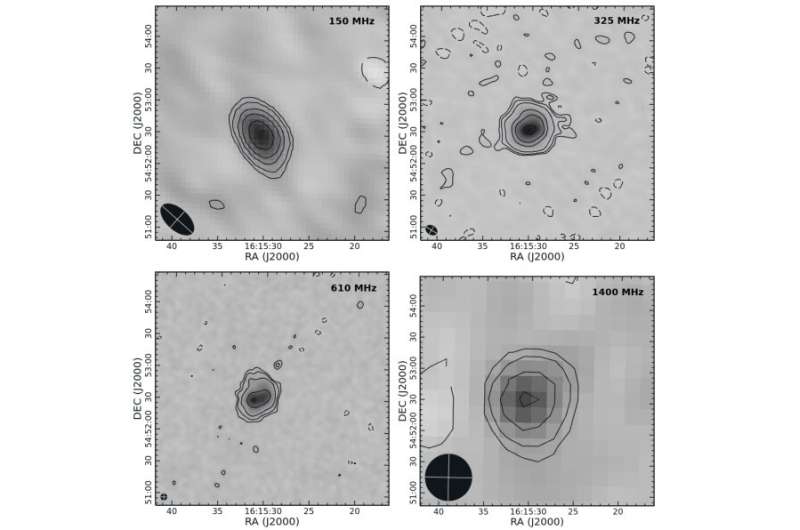Radio maps of the source J1615+5452 with the synthesized beam shown in the bottom left corner. Credit: Randriamanakoto et al., 2020.
Using the Giant Metrewave Radio Telescope (GMRT), astronomers from South Africa and India have discovered a new remnant radio galaxy. The newly detected object, designated J1615+5452 has a size exceeding 300,000 light years and showcases a diffuse amorphous radio emission. The finding is detailed in a paper published June 17 on arXiv.org.
Radio galaxies emit huge amounts of radio waves from their central cores. Black holes at the centers of these galaxies accrete gas and dust, generating high-energy jets visible in radio wavelengths, which accelerate electrically charged particles to high velocities.
During its active stage (lasting even 100 million years) typical radio galaxy is observed to contain such features like core, lobes, jets, and hotspots. However, after this stage passes, these signatures of activity generally disappear as the source's active galactic nucleus (AGN) switches off and the galaxy enters the so-called remnant or dying phase.
Astronomers are interested in finding new remnant AGNs as they represent the final stage in the evolution of a radio galaxy. Therefore, they are essential objects for improving the understanding of the radio galaxy life cycle. One of the methods to identify remnant AGNs is to search for ultra-steep spectra at low frequencies, however, only a handful of steep spectrum dying radio sources have been observed to date.
Now, a team of astronomers led by Zara Randriamanakoto of the South African Astronomical Observatory (SAAO) report the finding of a new remnant AGN. The discovery was made using data from GMRT and also from the Karl G. Jansky Very Large Array (VLA).
"In this work, we report the discovery of a new remnant radio galaxy, J1615+5452 in the field of the European Large-Area ISO Survey-North 1 (ELAIS-N1 or EN1, Oliver et al. 2000) from the GMRT 610 MHz observations. We used the archival low-frequency GMRT observations at 150 MHz and 325 MHz and 1400 MHz data from the Karl G. Jansky Very Large Array (VLA) to obtain the source radio spectrum and to reconstruct its history of AGN activity," the astronomers wrote in the paper.
The observations identified a dying AGN associated with J1615+5452, an early-type elliptical galaxy at a redshift of about 0.33. This radio galaxy appears to reside in a low-density environment.
According to the paper, J1615+5452 has an angular extent of over 300,000 light years, and exhibits a diffuse amorphous radio emission with no evidence of compact core, jets and hotspots. Moreover, high-resolution observations with VLA did not detect any radio counterparts of this source.
In general, the spectral features of J1615+5452, like high spectral curvature, suggest the predominance of non-thermal synchrotron emission with strong ongoing radiative losses. The synchrotron age of the source was found to be some 76 million years and the galaxy is estimated to have spent 30 percent of its total lifetime in the fading phase.
All in all, the researchers concluded that the results confirm the remnant radio galaxy status of J1615+5452.
"The morphological characteristics of J1615+5452 coupled with its spectral properties and synchrotron age helped us to classify the peculiar source as a dying radio galaxy," the authors of the paper wrote.
More information: J1615+5452: a remnant radio galaxy in the ELAIS-N1 field, arXiv:2006.10028 [astro-ph.GA] arxiv.org/abs/2006.10028
© 2020 Science X Network
























